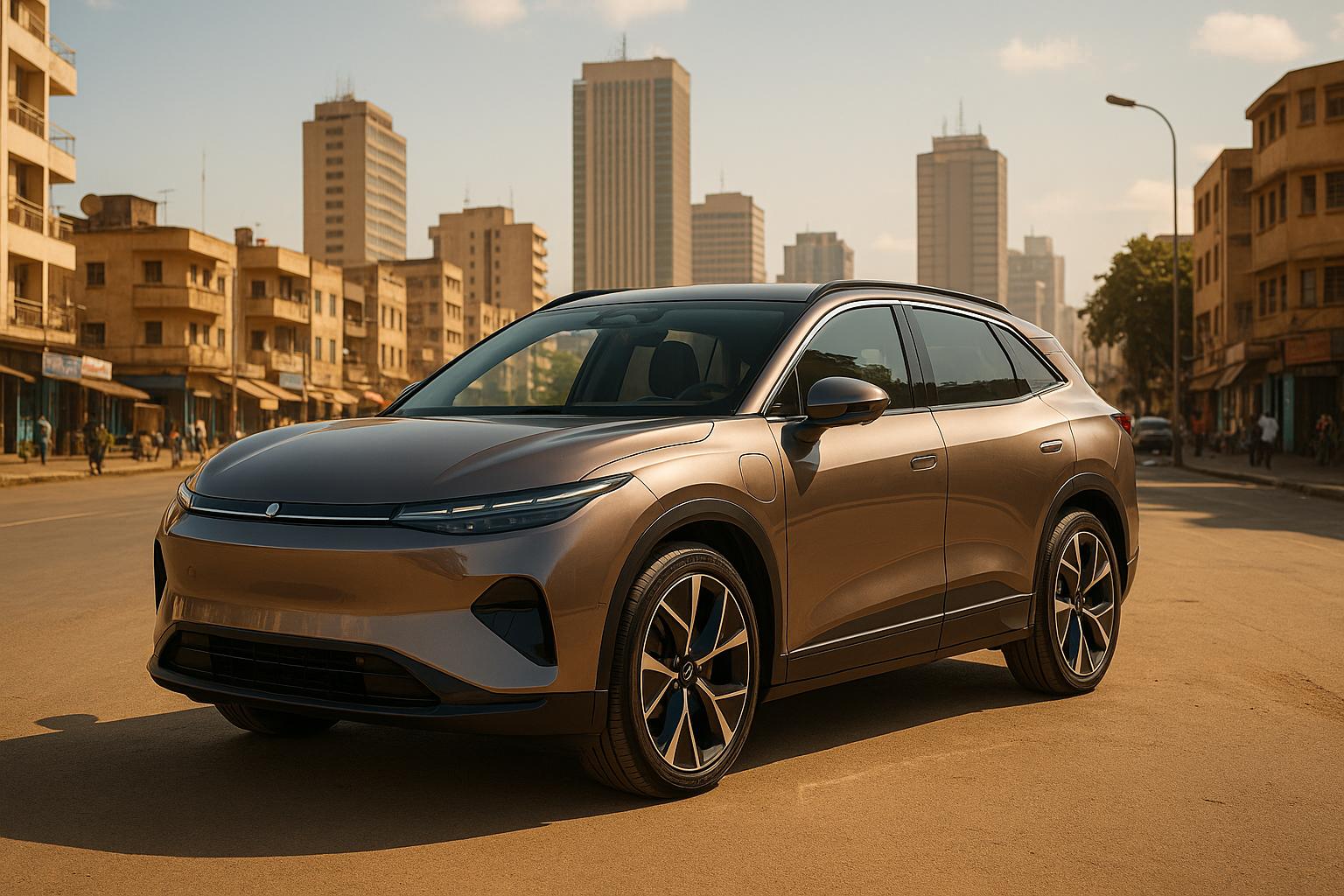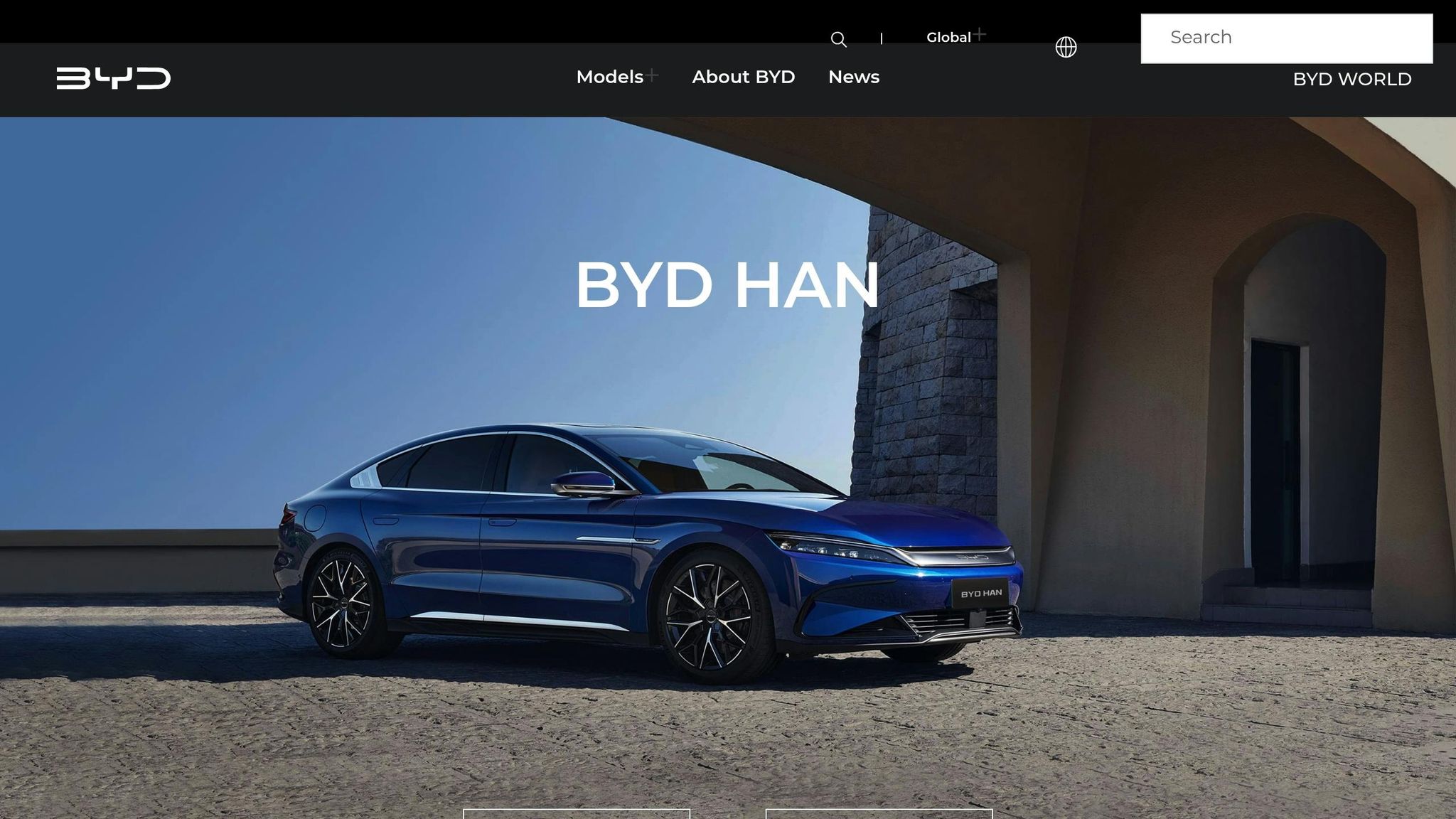
Chinese electric cars are reshaping Africa’s automotive market in 2025, offering affordable, reliable, and durable options tailored for local road conditions. Models like the BYD Dolphin, Chery Omoda E5, Neta V, BAIC EU5, and Geely Geometry C stand out for their pricing, range, and features. These vehicles are designed to handle Africa’s unique challenges, from rough terrains to limited charging infrastructure. Key highlights include:
- BYD Dolphin: $22,500, 248-mile range, 8-year battery warranty.
- Chery Omoda E5: $25,000, 310-mile range, fast charging.
- Neta V: $9,500–$13,000, 249-mile range, budget-friendly.
- BAIC EU5: $22,500, 248-mile range, sturdy design.
- Geely Geometry C: $30,000, 310-mile range, durable build.
Platforms like EV24.africa simplify importing, while government incentives, such as tax exemptions, further boost EV adoption. Chinese manufacturers are also expanding service networks, ensuring better support for buyers. These cars combine low upfront costs with long-term savings, making them practical choices for Africa’s transition to electric mobility.
Chinese EVs You Can Buy in Kenya – Africa EV Show
1. BYD Dolphin

The BYD Dolphin stands out as an economical and practical electric vehicle option for Africa in 2025. Its pricing and features make it a strong contender in an increasingly competitive market.
Affordability
With a starting price of under $22,500 (400,000 rand), the BYD Dolphin is one of the most budget-friendly electric vehicles available in African markets. Greg Cress from Accenture emphasizes:
As long as they remain affordable from an up-front cost perspective, they will be differentiated against legacy brands offering similar specifications.
This affordability aligns with a growing trend, as Chinese electric vehicle imports to Africa saw a 184% increase in 2025 compared to the previous year. The Dolphin is aimed at cost-conscious buyers looking to transition to electric vehicles.
Range and Battery Life
The Dolphin offers a solid range of 248 miles on a full charge, making it well-suited for urban and semi-urban travel across Africa. It also comes with a warranty covering battery performance for up to 8 years or 160,000 km (about 99,000 miles), providing peace of mind to buyers. In June 2025, the Dolphin recorded 18,106 deliveries in China – a 114.8% year-on-year increase – showcasing its growing popularity and potential for success in Africa.
Reliability and Durability
Beyond its affordability and range, the Dolphin is built to handle Africa’s challenging conditions. BYD, as the world’s largest electric vehicle manufacturer, produced over 12.4 million EVs in 2024, a testament to its expertise and commitment to quality. The Dolphin’s design prioritizes durability, ensuring it can navigate Africa’s varied terrains and climates. To further enhance reliability, BYD announced in June 2025 plans to expand its dealership network across Africa, including in Tanzania, to improve after-sales service and support.
Suitability for the African Market
The Dolphin focuses on practical features rather than luxury, making it a great match for African consumers. Its competitive pricing appeals to middle-class buyers who previously found electric vehicles out of reach. BYD’s efforts to improve cost efficiency and strengthen service reliability through local partnerships enhance its appeal across the region. Together, these factors position the Dolphin as a practical and accessible choice for Africa’s evolving market needs.
2. Chery Omoda E5

The Chery Omoda E5 stands out as a promising Chinese electric vehicle (EV) tailored for African markets, offering a blend of extended range, competitive pricing, and a durable design built to handle diverse driving conditions.
Range and Battery Life
The Omoda E5 delivers a solid range of about 310 miles (500 km) on a 61 kWh battery, making it a practical choice for longer trips. It also features fast-charging technology, reaching 80% capacity in just 30 minutes. In Q1 2025, its sibling model, the Chery Omoda C5, sold 1,628 units in South Africa alone, showcasing growing trust in Chery’s EV lineup.
Affordability
With a price tag of around $25,000, the Omoda E5 is positioned to appeal to Africa’s growing middle class. This pricing reflects its upgraded battery and extended range, making it an attractive option for budget-conscious buyers. Tony Liu, CEO of Chery South Africa, highlighted the company’s focus on the region, stating:
"We treat South Africa as a very important market for our global expansion."
Reliability and Durability
Built with Africa’s challenging road conditions in mind, the Omoda E5 features a sturdy design capable of handling rugged terrains, unpaved roads, and varying climates. Chery’s commitment to the region is further demonstrated by plans for local assembly operations, ensuring better access to parts and services while strengthening their foothold in Africa.
Suitability for the African Market
The Omoda E5 prioritizes practicality over luxury, making it a smart choice for regions where EV charging infrastructure is still developing. Its long range and quick-charging capabilities address key concerns for African drivers. The rise of new energy vehicle adoption across the continent – where sales doubled from 2023 to 2024, reaching 15,611 units – positions the E5 as a strong contender. Building on the success of models like the BYD Dolphin, the Omoda E5 reinforces the growing presence of Chinese EVs in Africa’s evolving automotive market.
3. Neta V

While models like the BYD Dolphin and Chery Omoda E5 come with higher specs and price tags, the Neta V takes a more straightforward, budget-friendly approach. This Chinese electric vehicle is tailored for Africa’s growing market, targeting first-time car buyers and ride-hailing operators looking for affordable and efficient options.
Affordability
With a price range of $9,500 to $13,000, the Neta V is an economical choice, offering a lower barrier to entry into the electric vehicle market. It also comes with reduced running costs compared to traditional gasoline-powered cars.
"The Neta V is positioned as one of the most cost-effective EV options on the market, making electric mobility accessible to a wider audience."
This affordability, combined with its efficient battery system, makes it a practical option for cost-conscious buyers.
Range and Battery Life
The Neta V is equipped with a 38.54 kWh battery that provides a range of up to 249 miles (401 kilometers) on a single charge. This makes it ideal for daily commutes in urban areas across Africa. Its energy efficiency shines in city driving, with a consumption rate of 9.6 kWh per 100 km, helping drivers maximize battery usage.
The car reaches 62 mph in 12.6 seconds and has a top speed of 75 mph. With a range that far exceeds the typical daily driving needs of most urban users, the Neta V helps alleviate range anxiety for potential buyers.
Fit for the African Market
Neta V’s strategy for Africa became evident in June 2025, when the company announced its entry into Kenya. By focusing on first-time car buyers and ride-hailing services, Neta demonstrates a clear understanding of the region’s transportation challenges and the increasing demand for electric vehicles.
The car is already proving its value in cities like Addis Ababa, where electric vehicles are gaining traction thanks to supportive government policies promoting e-mobility. Designed to balance affordability with reliable performance, the Neta V handles diverse terrains effectively, making it a strong choice for urban and semi-urban environments.
To ensure dependable after-sales service and access to spare parts, African buyers are encouraged to work with authorized local dealerships. This support network enhances the ownership experience and builds trust in the brand.
sbb-itb-99e19e3
4. BAIC EU5

The BAIC EU5 is making waves among African consumers looking for an affordable, practical electric vehicle. This Chinese-made sedan has carved out a niche for itself in markets like South Africa, offering a solid alternative to both traditional gasoline cars and pricier electric models.
Affordability
With a price tag under $22,500, the BAIC EU5 is within reach for many African buyers. BAIC keeps costs down through efficient production and subsidies, making it an appealing option for those transitioning from gas-powered vehicles to electric ones.
Reliability and Durability
One of the EU5’s standout features is its ability to handle Africa’s diverse road conditions. Built with a sturdy frame and higher ground clearance, it performs well on both urban streets and unpaved roads.
"The BAIC EU5 stands out for its affordability and range, making it a practical choice for navigating Africa’s diverse terrains." – Automotive Expert, IHKA Auto
In early 2025, the EU5 earned high marks in South Africa for its adaptability to both city driving and rural routes. While it’s not designed for extreme off-road adventures, its well-rounded build is more than capable of handling the variety of terrains most African drivers encounter daily.
Range and Battery Life
The EU5 offers a solid range of 248 miles (400 km) on a single charge, which is crucial in regions where charging stations are still sparse. This range makes it a dependable choice for both daily commutes and longer trips, easing concerns about running out of power and helping drivers feel more confident about switching to an electric vehicle.
Tailored for the African Market
BAIC has clearly designed the EU5 with African consumers in mind. Its combination of affordability, durability, and range addresses the key concerns for drivers across the continent. The car’s ability to handle varying road conditions while keeping costs manageable makes it a practical solution for dependable mobility.
For those considering the EU5, working with authorized local dealerships is essential to ensure proper maintenance and access to replacement parts. As electric vehicle adoption grows across Africa, the EU5’s thoughtful design and competitive pricing position it as a strong contender for anyone seeking a reliable and affordable electric car.
5. Geely Geometry C

The Geely Geometry C is making waves with its advanced features and competitive pricing, signaling Geely’s focused entry into Africa’s growing electric vehicle market.
Affordability
With a price tag of around $30,000, the Geometry C is positioned as an accessible option among Chinese electric vehicles in African markets. This pricing strategy underscores the emphasis Chinese manufacturers place on producing cost-efficient models rather than premium vehicles. Government subsidies and streamlined production processes further help keep the price within reach for consumers transitioning from gasoline-powered cars.
"Chinese exporters, including BYD as well as some smaller firms, are targeting many emerging and developing countries." – Joel Jaeger, Senior Research Associate, World Resources Institute
The affordability of the Geometry C doesn’t end with its sticker price. Rising fuel costs across Africa make its lower total cost of ownership a huge draw. Over time, the savings on fuel and maintenance can help offset the initial purchase price, making it an attractive option for budget-conscious buyers. Additionally, the vehicle’s design is tailored to handle Africa’s tough road conditions, adding to its overall value.
Reliability and Durability
Geely has designed the Geometry C with Africa’s challenging terrain in mind. Its sturdy chassis is built to handle both smooth urban roads and rugged rural paths with ease.
Geely’s commitment to the African market goes beyond just selling cars. The company plans to establish local assembly operations by 2025, which will not only help lower import costs but also allow for adjustments to better suit local needs. This initiative ensures the Geometry C can endure the diverse and often extreme weather conditions found across the continent, from humid coastlines to arid deserts.
Range and Battery Life
The Geometry C shines with an impressive range of about 310 miles (500 kilometers) on a single charge. This extended range addresses a key challenge in Africa – limited charging infrastructure – allowing drivers to travel long distances confidently.
The vehicle’s battery technology is engineered to perform reliably across a wide range of temperatures. This is especially important in Africa, where drivers may face everything from blistering desert heat to cooler mountain climates. The dependable battery life ensures the Geometry C remains a practical option for varying environments.
Suitability for African Market
The Geometry C checks all the boxes for what African consumers need: affordability, durability, and an extended range. Its 310-mile range makes it a practical choice for both daily commutes in bustling cities like Lagos or Nairobi and longer trips between urban hubs.
"As long as they remain affordable from an up-front cost perspective, they will be differentiated against legacy brands offering similar specifications." – Greg Cress, Accenture
For importers, the Geometry C is a smart choice in the expanding African electric vehicle market. Its blend of cost-effectiveness, strong performance, and thoughtful design makes it a compelling option as Africa moves toward greater adoption of electric mobility.
Comparison of Features and Drawbacks
When choosing an electric vehicle (EV) for Africa’s diverse driving conditions, factors like upfront cost, battery capacity, warranty, and ground clearance play a crucial role. Below is a table summarizing the key specifications of five models:
| Model | Price (USD) | Range (miles/km) | Battery Size (kWh) | Charging Time | Ground Clearance (inches/mm) | Warranty/Support Options |
|---|---|---|---|---|---|---|
| BYD Dolphin | $32,000 | 265 miles (426 km) | 60.48 kWh | 30 min (DC) | 6.5 inches (165 mm) | 8 years/100,000 miles |
| Chery Omoda E5 | $36,000 | 300 miles (483 km) | 70 kWh | 30 min (DC) | 7.1 inches (180 mm) | 5 years/60,000 miles |
| Neta V | $30,000 | 250 miles (402 km) | 50 kWh | 30 min (DC) | 6.3 inches (160 mm) | 5 years/60,000 miles |
| BAIC EU5 | $34,000 | 260 miles (418 km) | 61.4 kWh | 30 min (DC) | 6.7 inches (170 mm) | 5 years/60,000 miles |
| Geely Geometry C | $35,000 | 300 miles (483 km) | 70 kWh | 30 min (DC) | 7.0 inches (178 mm) | 5 years/60,000 miles |
The Neta V, priced at $30,000, is the most affordable option, making it attractive for budget-conscious buyers. However, its smaller 50 kWh battery and 250-mile range might limit its suitability for longer trips, especially in areas with sparse charging infrastructure.
The BYD Dolphin, at $32,000, offers a standout 8-year/100,000-mile warranty, which could be a major plus in regions where servicing options are still catching up. However, its 6.5-inch ground clearance may not perform as well on rough rural roads, and its 265-mile range could pose challenges for extended intercity travel.
For those prioritizing range, the Chery Omoda E5 and Geely Geometry C both deliver 300 miles, easing concerns about range anxiety. The Chery Omoda E5 edges ahead with a higher ground clearance of 7.1 inches, enhancing its capability on uneven terrain. Meanwhile, the Geometry C offers similar features at a slightly lower price of $35,000 compared to the Omoda E5’s $36,000.
The BAIC EU5, priced at $34,000, strikes a balance with its 260-mile range and 6.7-inch ground clearance. While not leading in any single category, it offers steady performance across key metrics.
Ultimately, the choice depends on priorities like warranty, ground clearance, and range. For buyers seeking affordability, the Neta V is a solid entry-level option. However, those needing longer warranties and better ground clearance may lean toward the BYD Dolphin, Chery Omoda E5, or Geely Geometry C. Since all models share the same charging time, the availability of fast-charging infrastructure in the region will also play a pivotal role in the decision-making process.
Conclusion
These five Chinese electric vehicles (EVs) offer an appealing mix of affordability, durability, and designs tailored specifically for African conditions.
Projections suggest Africa’s new energy vehicle market will surpass 30,000 units by 2025, with Chinese brands expected to claim over 60% of the market share. This growth highlights manufacturers’ efforts to adapt their vehicles for African needs, including features like right-hand drive configurations and durable battery systems.
Beyond individual savings, the economic ripple effects are significant. Automakers are investing in local assembly plants and dealership networks. For instance, BYD plans to triple its dealership footprint in South Africa, while BAIC has set its sights on producing 50,000 vehicles annually in Egypt. These developments not only create jobs but also align with broader sustainability efforts.
Efficient EV imports are also a key factor in supporting Africa’s climate goals by reducing dependency on fossil fuels. With practical ranges and fast-charging capabilities, these vehicles are well-suited for both city commutes and longer journeys.
To make the transition easier, platforms like EV24.africa handle the complexities of importing EVs across the continent. From shipping and customs to registration, they ensure the process is straightforward and transparent.
"At EV24.africa, we simplify the process of importing and buying electric vehicles in Africa. Our expertise ensures a seamless, transparent, and stress-free experience, so you can focus on driving the future of mobility."
Competitive pricing further solidifies their appeal. For example, the BYD Dolphin Active is available for just $11,800.
As charging infrastructure continues to grow and partnerships strengthen, these five Chinese EVs stand out as practical, forward-thinking solutions for Africa’s evolving transportation landscape.
FAQs
What are the main advantages of importing Chinese electric vehicles to Africa, and how do they address the region’s specific needs?
Importing electric vehicles (EVs) from China to Africa brings several practical benefits. For starters, these vehicles are often budget-friendly, offering an economical option for many African buyers. They’re also built with durability in mind, featuring designs that can handle the varied terrains and tough road conditions commonly found across the continent.
On top of that, Chinese EVs help cut transportation costs by reducing reliance on pricey fossil fuels. They also play a role in reducing emissions, aligning with Africa’s increasing interest in renewable energy and electric mobility. This makes them a smart and forward-looking choice for the region.
How does the availability of charging stations in Africa impact the practicality of owning electric cars like the BYD Dolphin or Chery Omoda E5?
The availability of charging stations is a key factor when it comes to owning an electric vehicle in Africa. Take the Chery eQ7, for example – it supports DC fast charging, which can bring the battery from 0% to 80% in just about 30 minutes. This feature is especially useful in areas where charging infrastructure is still developing. On the other hand, the BYD Seagull stands out with its flexible charging options, making it adaptable to various setups. Then there’s the Wuling Hongguang MINI EV, which relies on standard AC charging, perfect for basic home or office use.
As charging networks grow across the continent, owning an EV is becoming more practical. That said, it’s essential to evaluate the charging capabilities of different models to ensure they match the infrastructure available in your area.
How do government incentives and local assembly affect the adoption of Chinese electric vehicles in Africa?
Government initiatives and local assembly efforts are playing a major role in increasing the presence of Chinese electric vehicles (EVs) across Africa. Measures like tax rebates and subsidies for EVs assembled within the region help lower costs for buyers while motivating manufacturers to set up production facilities locally.
By assembling vehicles on the continent, manufacturers cut down on import expenses, create jobs, and contribute to building infrastructure designed specifically for African markets. These combined efforts make EVs more affordable, practical, and better suited to meet the unique demands of the region.




